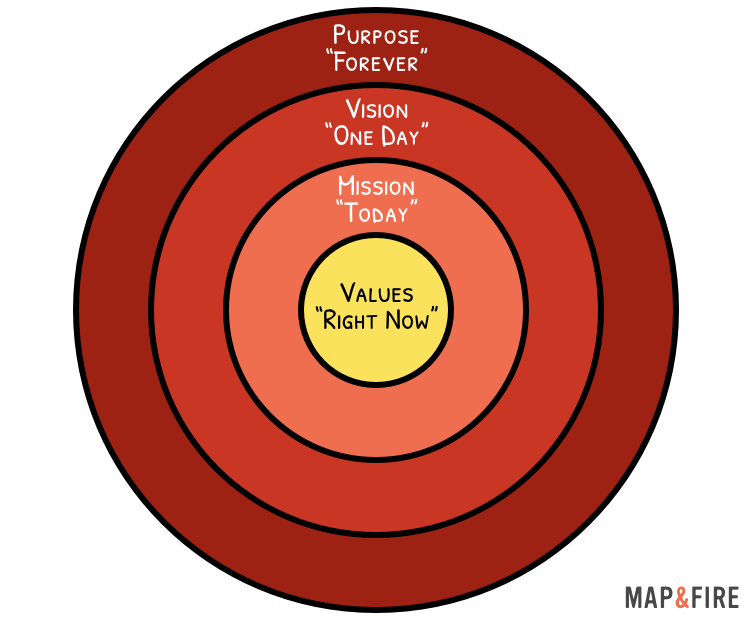How To Define Your Brand’s Purpose, Vision, Mission, and Values.
Develop these key strategic brand statements to align your team, build trust with your customers, and articulate your brand’s direction in a concise and memorable way.

Our Content Is Featured In:

Join 6,379 folks who receive our latest insights and you'll get immediate access to our 10 page brand strategy workbook!
Instantly analyze your brand
Use our new positioning app, SmokeLadder, to see where your B2B brand is strong, weak, and where it can stand out from the competition.
Does Every Brand Need A Big Picture Strategy?
The immediate and long-term benefits of defining your strategic guardrails.
It’s true that strategic statements and lists don’t mean much on their own. Like any important tool, the value doesn’t come simply by having them, but from how they’re used and embodied by your brand.
But if you don’t start by thinking about, defining, and sharing the foundation of what you’re striving for, how can you expect everyone to embody the same things? How can you maintain consistency? What gauge will you have to evaluate if things are on or off course?
By taking the time to think through these ideas and write them down, it forces you to create a clear direction in your own head, and uncovers any misalignment or confusion there might be with cofounders or team members.
And these tools aren’t just theory. They provide the guardrails to keep your brand on a consistent path in the larger, big picture sense as well as in terms of day-to-day decision making and behaviors.
So yes, if you want to be clear about where you’re going, what you hope to accomplish, and how you’ll get there, every brand should take the time to define these concepts.
Purpose: Your Brand’s “Forever”
It’s the aspirational reason why your company exists. It lives beyond financial goals and doesn’t include any methods, means, or specific approaches or executions.


Vision: Your Brand’s “One Day”
This is your brand’s “envisioned future”. It’s a description of what the world could be like if you achieve everything you set out to do. It speaks to the impact you’ll make in the lives of your customers, not just the future state of your own company.
Vision: Your Brand’s “One Day”
This is your brand’s “envisioned future”. It’s a description of what the world could be like if you achieve everything you set out to do. It speaks to the impact you’ll make in the lives of your customers, not just the future state of your own company.

Mission: Your Brand’s “Today”
Your Mission Statement describes exactly how you’ve put your purpose into action, along with who benefits from your work. It outlines your actions in simple, clear language that’s specific to your brand.


Values: Your Brand’s “Right Now”
Core Values describe what you believe and how you behave. They’re a brand’s standards of conduct even (and especially) when things get difficult.
Values: Your Brand’s “Right Now”
Core Values describe what you believe and how you behave. They’re a brand’s standards of conduct even (and especially) when things get difficult.

You’ve Created Your Strategy, Now Use It!
Practical tips to integrate your big picture strategy into your business and brand.
Once you’ve gone through the process to define these concepts, you get to decide how you want to utilize them to help guide your business.
Your Core Purpose might serve mainly as a guide for the founders.
Your Vision Statement might get shared and discussed only with your internal team.
Your Mission Statement and Core Values may be pieces that get placed on your website so that your team and customers can get a clear understanding of what you do and how you do it.
Here are some additional ways to integrate your big picture strategy into your business and brand.
- As much as possible, get input and feedback on these statements from leadership and the wider team. While it’s leadership’s job to ensure everyone understands the brand’s direction, the team itself needs to buy into it and uphold it on a daily basis. The more people believe they have a voice in that strategy the more aligned they’ll feel.
- Review all of the statements and values on a regular (at least quarterly) basis to make sure they still feel relevant and aligned with current business activities. This strategy should serve as a system of a checks and balances to make sure the brand stays on track with its most important goals.
- When new projects and initiatives are proposed, test them against the big picture strategy. It should always be clear how they help push the greater brand mission forward while staying in alignment with the values of the business.
- When disagreements around direction come up, ground discussion around the mission and values. Allow your agreed upon strategy to serve as an impartial 3rd party to fuel healthy, constructive debate.
- Use the brand values as a way to recognize and reward individuals or work that exemplifies what the business believes in. The more people see direct connections between their work and the values, the more they’ll continue to strive to uphold them.
Get Help Developing The Big Picture Strategy Of Your Brand

Free Brand & Marketing Workbook
Get immediate access to our 10 page workbook to help you define your Core Purpose, Vision, and Core Values, along with resources for Brand Archetypes, Tone of Voice, Messaging, and more!

Hands-on Brand Strategy Help
Transform your best business thinking into an actionable, shareable, growth-oriented guide. Click below to learn about the Brand Guidebook process.

